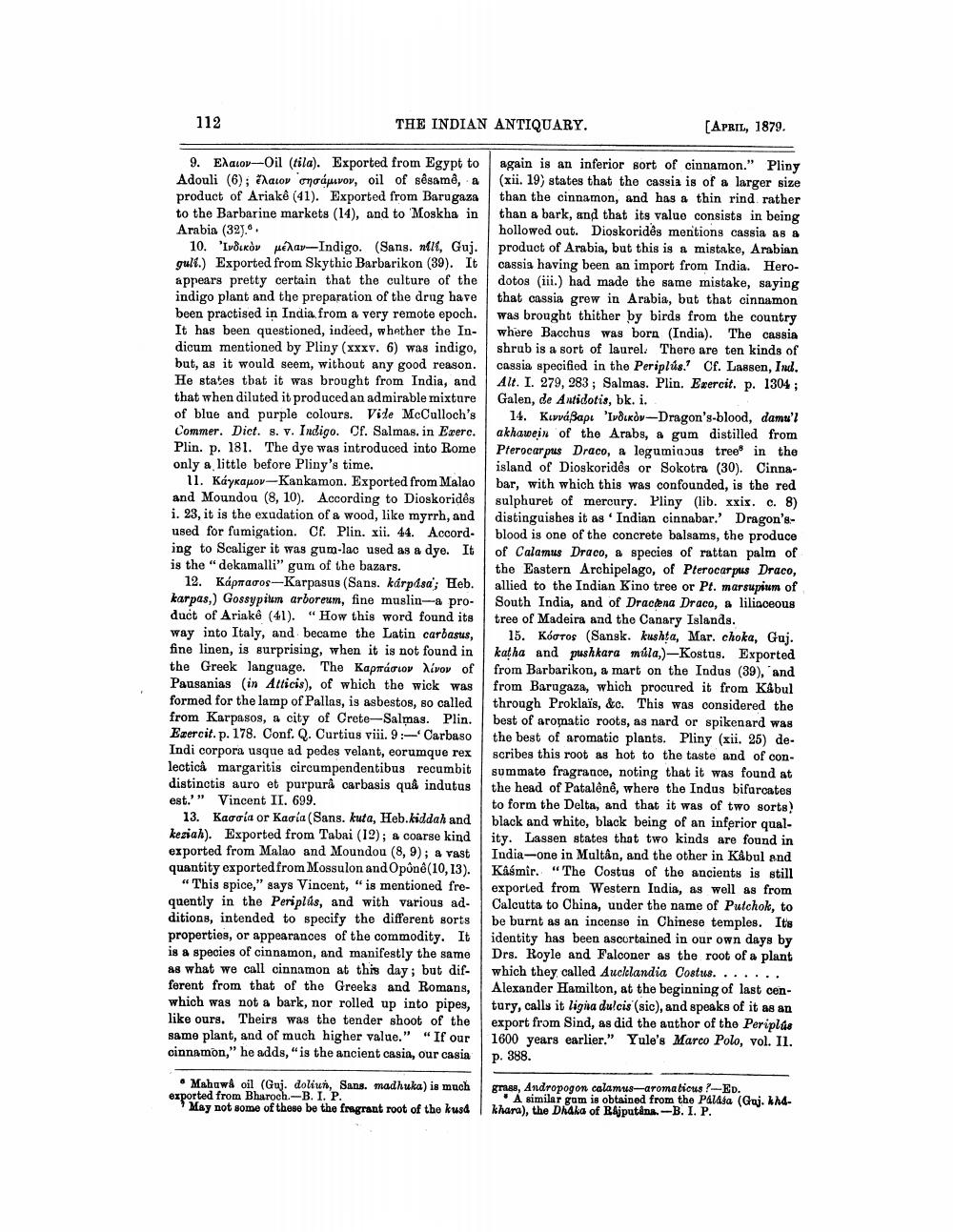________________
112
THE INDIAN ANTIQUARY.
9. Exator-Oil (tila). Exported from Egypt to Adouli (6); atov enoáμvov, oil of sêsamê, a product of Ariakê (41). Exported from Barugaza to the Barbarine markets (14), and to 'Moskha in Arabia (32)..
10. 'Ivoiкó péλav-Indigo. (Sans. ntli, Guj. guli.) Exported from Skythic Barbarikon (39). It appears pretty certain that the culture of the indigo plant and the preparation of the drug have been practised in India from a very remote epoch. It has been questioned, indeed, whether the Indicum mentioned by Pliny (xxxv. 6) was indigo, but, as it would seem, without any good reason. He states that it was brought from India, and that when diluted it produced an admirable mixture of blue and purple colours. Vide McCulloch's Commer. Dict. s. v. Indigo. Cf. Salmas. in Exerc. Plin. p. 181. The dye was introduced into Rome only a little before Pliny's time.
11. Káyкaμov-Kankamon. Exported from Malao and Moundou (8, 10). According to Dioskoridês i. 23, it is the exudation of a wood, like myrrh, and used for fumigation. Cf. Plin. xii. 44. According to Scaliger it was gum-lac used as a dye. It is the "dekamalli" gum of the bazars.
12. Káрravos-Karpasus (Sans. kárpása; Heb. karpas,) Gossypium arboreum, fine muslin-a product of Ariakê (41). "How this word found its way into Italy, and became the Latin carbasus, fine linen, is surprising, when it is not found in the Greek language. The Kapráσtov λívov of Pausanias (in Atticis), of which the wick was formed for the lamp of Pallas, is asbestos, so called from Karpasos, a city of Crete-Salmas. Plin. Exercit. p. 178. Conf. Q. Curtius viii. 9:- Carbaso Indi corpora usque ad pedes velant, eorumque rex lecticâ margaritis circumpendentibus recumbit distinctis auro et purpurâ carbasis quâ indutus est.'" Vincent II. 699.
13. Kaoría or Karía (Sans. kuta, Heb.kiddah and keziah). Exported from Tabai (12); a coarse kind exported from Malao and Moundou (8, 9); a vast quantity exported from Mossulon and Opûnê (10, 13).
"This spice," says Vincent, "is mentioned frequently in the Periplús, and with various additions, intended to specify the different sorts properties, or appearances of the commodity. It is a species of cinnamon, and manifestly the same as what we call cinnamon at this day; but different from that of the Greeks and Romans, which was not a bark, nor rolled up into pipes, like ours. Theirs was the tender shoot of the same plant, and of much higher value." "If our cinnamon," he adds, "is the ancient casia, our casia
Mahawa oil (Guj. doliun, Sans. madhuka) is much exported from Bharoch.-B. I. P.
May not some of these be the fragrant root of the kusd
[APRIL, 1879.
again is an inferior sort of cinnamon." Pliny (xii. 19) states that the cassia is of a larger size than the cinnamon, and has a thin rind rather than a bark, and that its value consists in being hollowed out. Dioskoridês mentions cassia as a product of Arabia, but this is a mistake, Arabian cassia having been an import from India. Herodotos (iii.) had made the same mistake, saying that cassia grew in Arabia, but that cinnamon was brought thither by birds from the country where Bacchus was born (India). The cassia shrub is a sort of laurel. There are ten kinds of cassia specified in the Periplús. Cf. Lassen, Ind. Alt. I. 279, 283; Salmas. Plin. Exercit. p. 1304; Galen, de Antidotis, bk. i.
14. Kivváßapi Ivdikov-Dragon's-blood, damu'l akhawein of the Arabs, a gum distilled from Pterocarpus Draco, a leguminous tree in the island of Dioskoridês or Sokotra (30). Cinnabar, with which this was confounded, is the red sulphuret of mercury. Pliny (lib. xxix. c. 8) distinguishes it as 'Indian cinnabar.' Dragon'sblood is one of the concrete balsams, the produce of Calamus Draco, a species of rattan palm of the Eastern Archipelago, of Pterocarpus Draco, allied to the Indian Kino tree or Pt. marsupium of South India, and of Dracena Draco, a liliaceous tree of Madeira and the Canary Islands.
15. Kóσros (Sansk. kushta, Mar. choka, Guj. katha and pushkara múla,)-Kostus. Exported from Barbarikon, a mart on the Indus (39), and from Barugaza, which procured it from Kâbul through Proklaïs, &c. This was considered the best of aromatic roots, as nard or spikenard was the best of aromatic plants. Pliny (xii. 25) describes this root as hot to the taste and of consummate fragrance, noting that it was found at the head of Patalênê, where the Indus bifurcates to form the Delta, and that it was of two sorts) black and white, black being of an inferior quality. Lassen states that two kinds are found in India-one in Multân, and the other in Kâbul and Kâśmir. "The Costus of the ancients is still exported from Western India, as well as from Calcutta to China, under the name of Putchok, to be burnt as an incense in Chinese temples. It's identity has been ascertained in our own days by Drs. Royle and Falconer as the root of a plant which they called Aucklandia Costus...... Alexander Hamilton, at the beginning of last century, calls it ligha dulcis (sic), and speaks of it as an export from Sind, as did the author of the Periplás 1600 years earlier." Yule's Marco Polo, vol. II. p. 388.
grass, Andropogon calamus-aromaticus?-ED. A similar gum is obtained from the Pálása (Gaj. khakhara), the Dhaka of Rajputana.-B. I. P.




